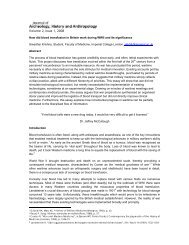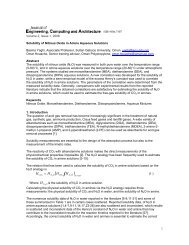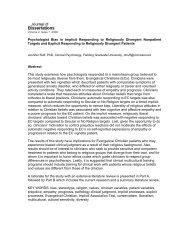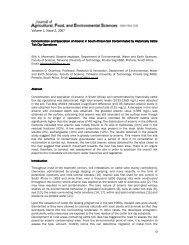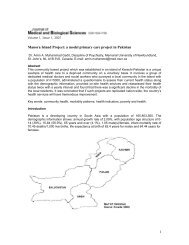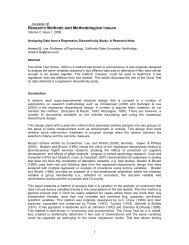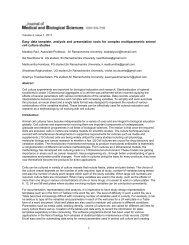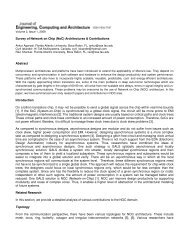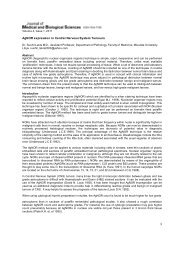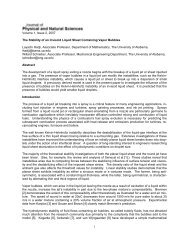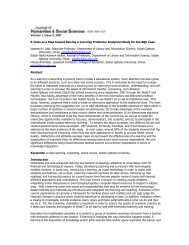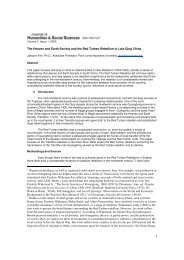A Simulated Annealing Based Approach for ATM Network Optimization
A Simulated Annealing Based Approach for ATM Network Optimization
A Simulated Annealing Based Approach for ATM Network Optimization
Create successful ePaper yourself
Turn your PDF publications into a flip-book with our unique Google optimized e-Paper software.
LR finds better solutions than the GA. <strong>ATM</strong> network design deals with determination of location <strong>for</strong> the<br />
switches and linking the switches [Hasslinger et. al., 2005]. One of the limiting factors in the design of the<br />
<strong>ATM</strong> network as can be deduced from the above literatures is the requirement of expensive exchange based<br />
equipments. [Thomson, 2000] Compared the meta-heuristics GA and SA to solve the design problem of <strong>ATM</strong><br />
but their approach to <strong>ATM</strong> design suffers from the abovementioned limitation. In this paper we have<br />
proposed Passive Optical <strong>Network</strong> as a solution to the problem. It provides a way to gradually introduce<br />
fiber optic technology into access networks while still deploying parts of the traditional copper line or coaxial<br />
cable systems. These networks allow many different configuration options and as such will place new<br />
demands on network planners. Most of the literatures available with respect to PON <strong>ATM</strong>’s pertain to the<br />
Steiner tree topology implementation. In this paper we have addressed and solved using <strong>Simulated</strong><br />
<strong>Annealing</strong> the comprehensive <strong>ATM</strong> network design problem which deals with the backbone network design<br />
using the ring topology. Ring architecture is considered cost effective in that they offer high network<br />
survivability in the face of node failure and greater bandwidth sharing [Wu, et. al., 1998]. And also the<br />
problem of end-user connectivity with the backbone network has been addressed.<br />
<strong>Simulated</strong> <strong>Annealing</strong><br />
The method was proposed by Kirkpatrick et al.(1993) and has since been used extensively to solve largescale<br />
problems of combinatorial optimization. SA is based on the annealing of metals. If a metal is cooled<br />
slowly, it <strong>for</strong>ms into a smooth piece because its thermal mobility is lost and molecules have entered a crystal<br />
structure. This crystal is the state of minimum energy can also be termed as the optimal solution <strong>for</strong> the<br />
system. On the other hand at high temperatures, the molecules of a liquid move freely with respect to one<br />
another and if a metal is cooled too fast, the metal will <strong>for</strong>m a rough piece. So the effectiveness of the<br />
simulated annealing algorithm lies in slow cooling of the temperature [Sheshadri]. One of the features of SA<br />
is its ability to come out of local minima as worst moves are allowed in the algorithm based on some<br />
probabilistic condition. In large scale optimization problem, which comprises of many local maxima and<br />
minima, moving out of local minima is very important to get global optima. The major steps involved in SA<br />
are- Initialization: defines how to get the initial feasible solution. The next step is the Iteration: defines the<br />
neighborhood, temperature schedule, how many iterations per temperature, and criteria <strong>for</strong> reducing the<br />
temperature. Last step Termination: defines a terminating condition.<br />
Problem Description<br />
While planning <strong>ATM</strong> network design there are two sets of customers to be considered, the user who would<br />
be using the services through the network and the company that will be building the <strong>ATM</strong> network and<br />
maintaining it. There<strong>for</strong>e while planning the <strong>ATM</strong> networks there are two principal objectives to be<br />
considered. One, the network should meet the end-users needs in terms of quality of service and cost. Two,<br />
<strong>for</strong> the network operator it should be as cost effective as possible to install and maintain the network. The<br />
second objective has traditionally been examined as reducing the first installed cost of the network.<br />
Minimizing the total cost is mainly a matter of finding shortest paths between the <strong>ATM</strong> nodes, as in installing<br />
a new network most of the money is spent on digging the cable ducts.



